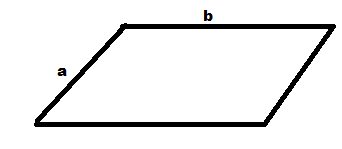
One side of the parallelogram is 4.8 cm and the other is $\dfrac{3}{2}$ times the first side . Find the perimeter of the parallelogram
Answer
575.7k+ views
Hint: We are given one side a and the other side is $\dfrac{3}{2}$ times of a . So we get the other side by multiplying $\dfrac{3}{2}$ by a and the perimeter of the parallelogram is given by 2 * ( sum of the sides)
Complete step-by-step answer:
We are given that one side of the parallelogram is 4.8 cm
That is , a = 4.8 cm

We are given that the other side is $\dfrac{3}{2}$ times the first side
Let the other side be b
Therefore b = $\dfrac{3}{2}$ times a
$
\Rightarrow b = \dfrac{3}{2}*4.8 \\
\Rightarrow b = 3*2.4 = 7.2cm \\
$
Now we have the sides of the parallelogram to be 4.8 cm and 7.2 cm
Perimeter of parallelogram = 2 * ( sum of the sides)
$
= 2(a + b) \\
= 2(4.8 + 7.2) \\
= 2(12) \\
= 24cm \\
$
Therefore the perimeter of the parallelogram is 24 cm.
Note: In a parallelogramABCD,
1.Opposite sides are congruent (AB = DC).
2.Opposite angles are congruent (D = B).
3.Consecutive angles are supplementary (A + D = 180°).
4.If one angle is right, then all angles are right.
5.The diagonals of a parallelogram bisect each other.
6.Each diagonal of a parallelogram separates it into two congruent triangles.
Complete step-by-step answer:
We are given that one side of the parallelogram is 4.8 cm
That is , a = 4.8 cm

We are given that the other side is $\dfrac{3}{2}$ times the first side
Let the other side be b
Therefore b = $\dfrac{3}{2}$ times a
$
\Rightarrow b = \dfrac{3}{2}*4.8 \\
\Rightarrow b = 3*2.4 = 7.2cm \\
$
Now we have the sides of the parallelogram to be 4.8 cm and 7.2 cm
Perimeter of parallelogram = 2 * ( sum of the sides)
$
= 2(a + b) \\
= 2(4.8 + 7.2) \\
= 2(12) \\
= 24cm \\
$
Therefore the perimeter of the parallelogram is 24 cm.
Note: In a parallelogramABCD,
1.Opposite sides are congruent (AB = DC).
2.Opposite angles are congruent (D = B).
3.Consecutive angles are supplementary (A + D = 180°).
4.If one angle is right, then all angles are right.
5.The diagonals of a parallelogram bisect each other.
6.Each diagonal of a parallelogram separates it into two congruent triangles.
Recently Updated Pages
Master Class 8 Social Science: Engaging Questions & Answers for Success

Master Class 8 Maths: Engaging Questions & Answers for Success

Master Class 8 Science: Engaging Questions & Answers for Success

Class 8 Question and Answer - Your Ultimate Solutions Guide

Master Class 8 English: Engaging Questions & Answers for Success

Why are manures considered better than fertilizers class 11 biology CBSE

Trending doubts
What is BLO What is the full form of BLO class 8 social science CBSE

Citizens of India can vote at the age of A 18 years class 8 social science CBSE

Full form of STD, ISD and PCO

Right to vote is a AFundamental Right BFundamental class 8 social science CBSE

What is the difference between rai and mustard see class 8 biology CBSE

Summary of the poem Where the Mind is Without Fear class 8 english CBSE




